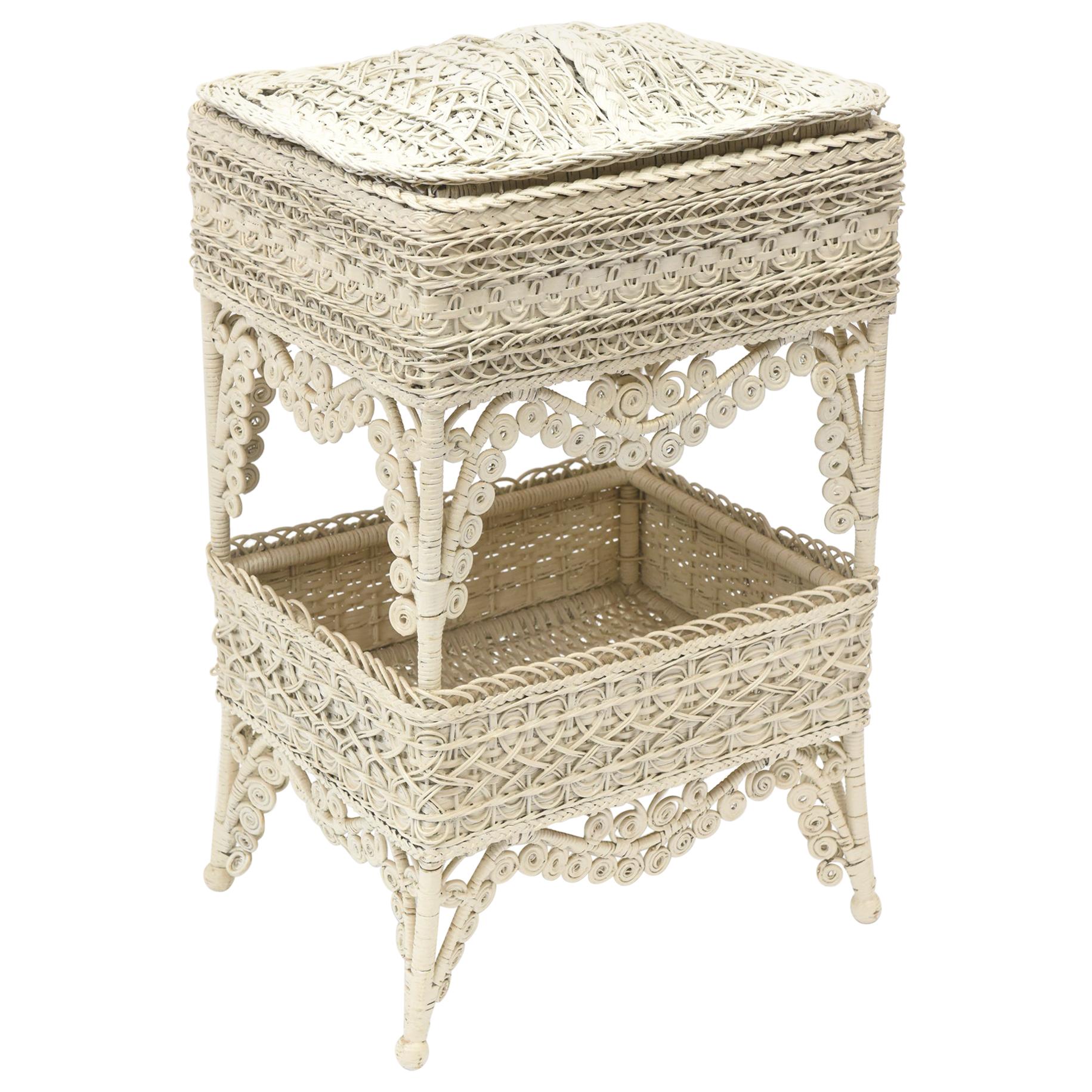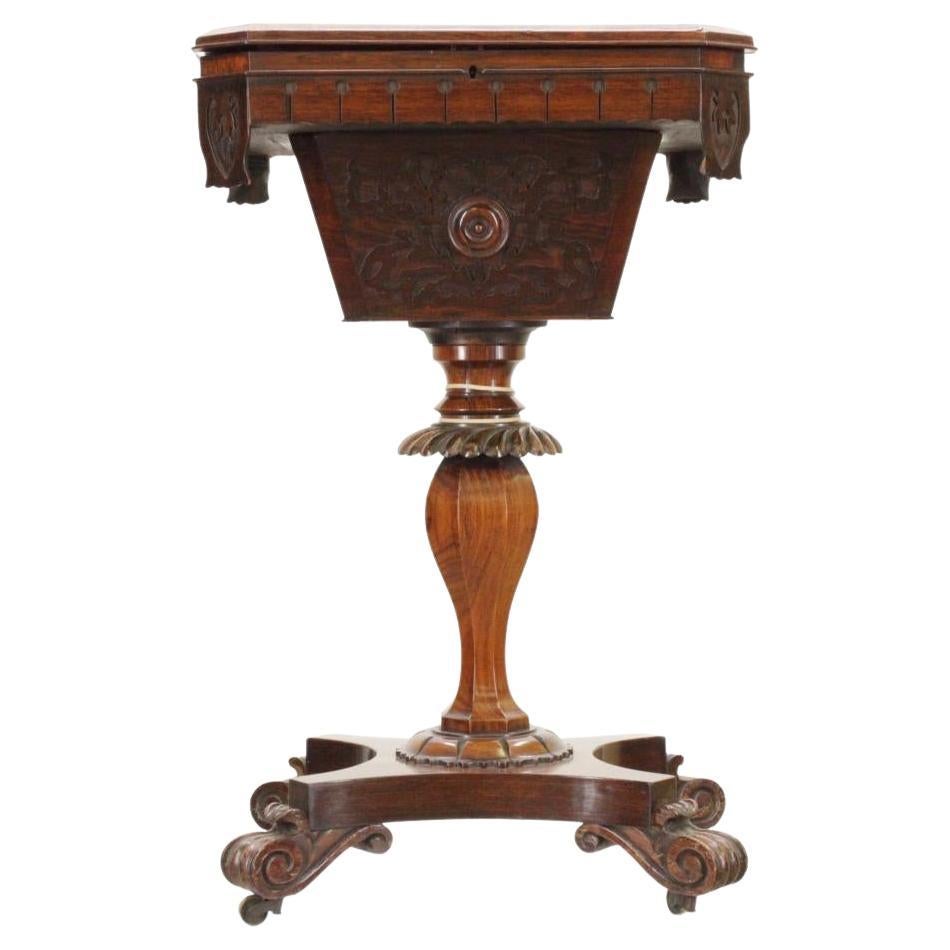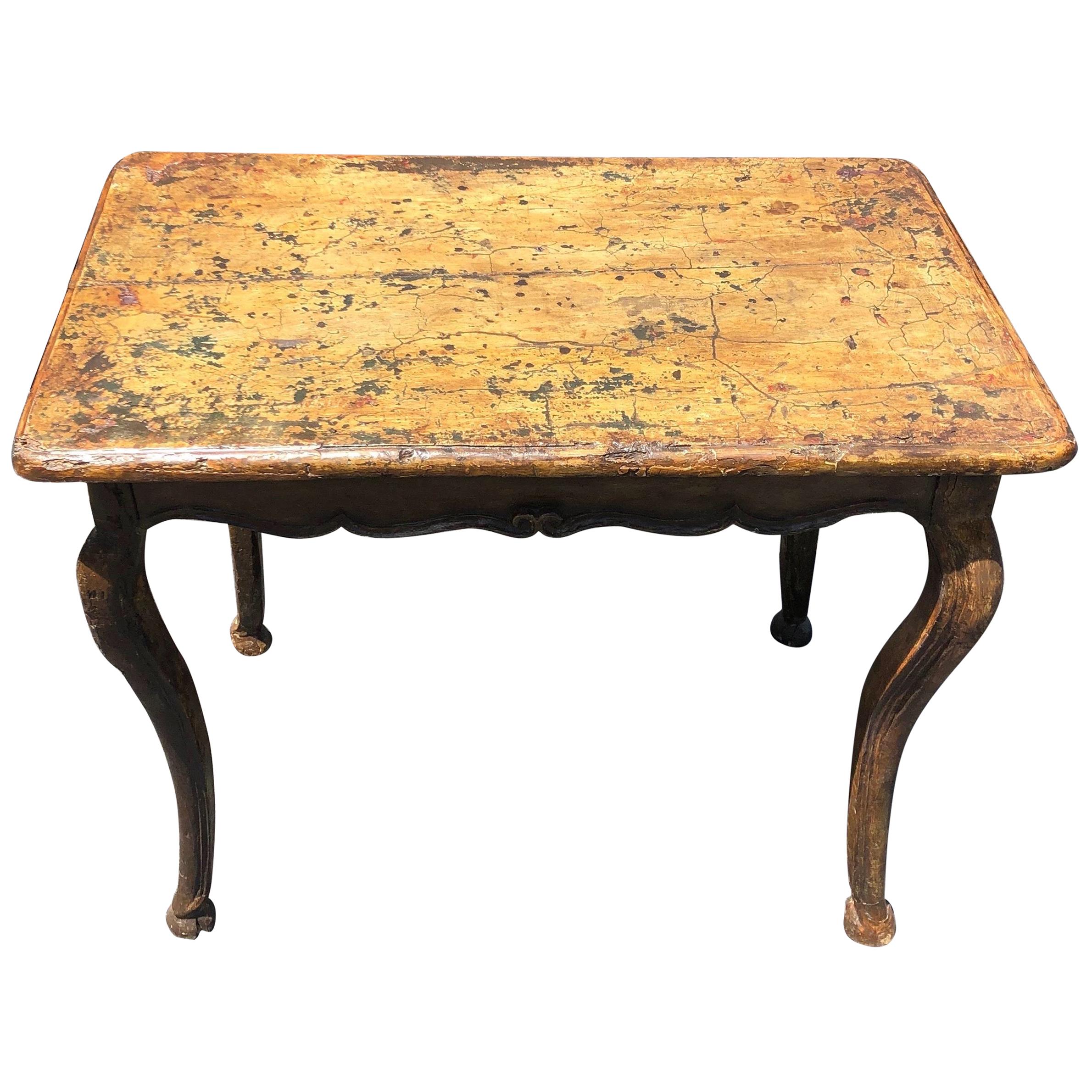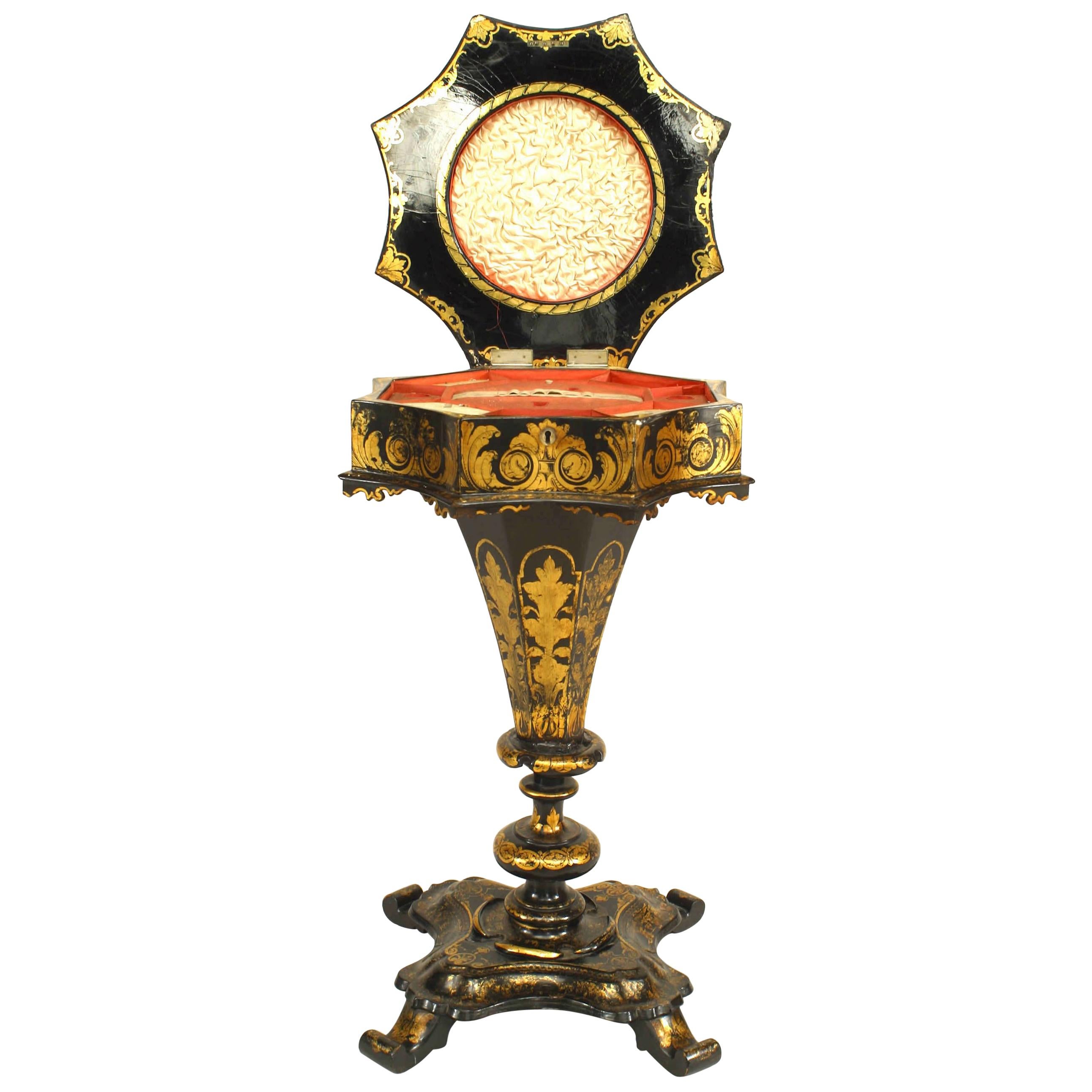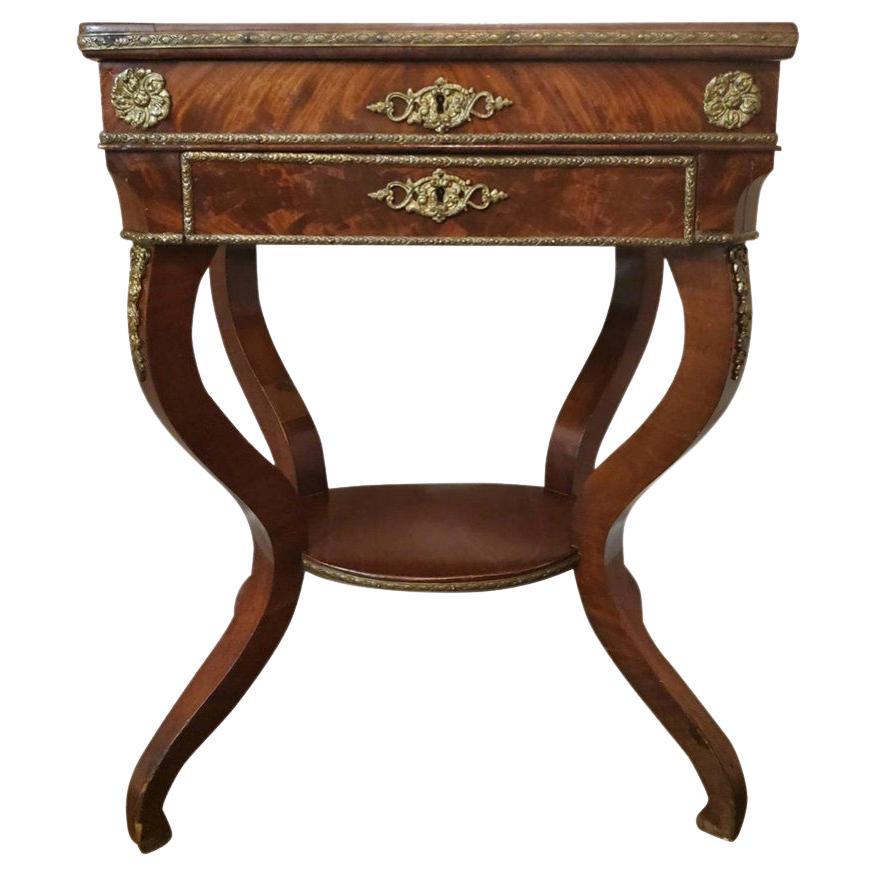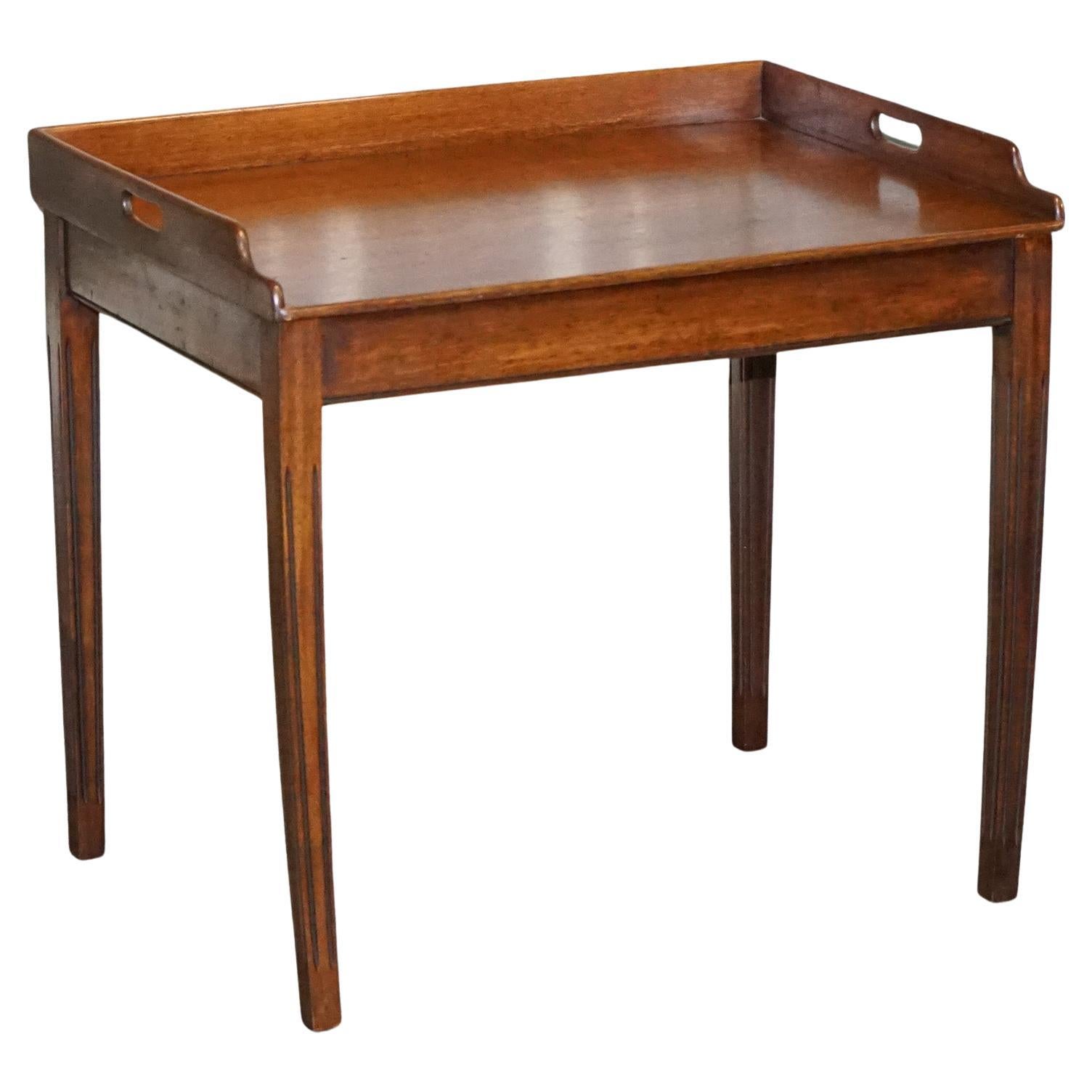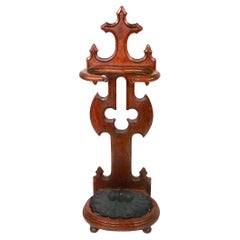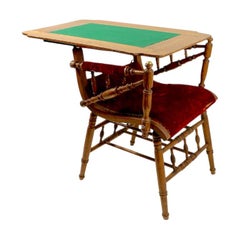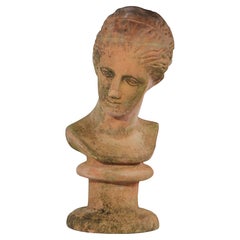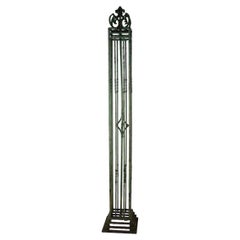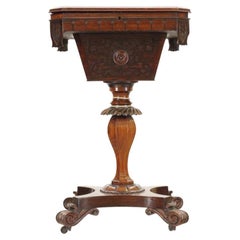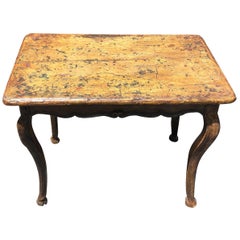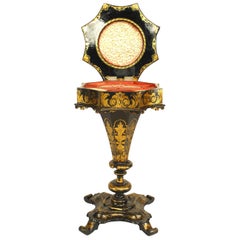Items Similar to Victorian Black Lacquer Paint Decorated Sewing Stand 19th C.
Want more images or videos?
Request additional images or videos from the seller
1 of 21
Victorian Black Lacquer Paint Decorated Sewing Stand 19th C.
About the Item
High End Victorian sewing stand in very good, original condition. The stand features a hand painted foliate themed top, depicting ferns surrounded by a geometric gilt border. The turned vertical standard and cabriole legs also display hand painted polychrome trim on a black ground. The hinged top opens to reveal a fitted interior, upholstered in purple satin fabric, with off white satin trim, and brass handles.
The stand is in very fine, original, clean and ready to use condition, showing only light cosmetic wear normal and consistent with age.
19th C vintage, English, or American in origin, unsigned. Elegant, charming and decorative antique table, perfect accent piece for your home.
- Dimensions:Height: 27.5 in (69.85 cm)Diameter: 18.5 in (46.99 cm)
- Style:Victorian (Of the Period)
- Materials and Techniques:Wood,Hand-Painted,Lacquered
- Place of Origin:United States
- Period:19th Century
- Date of Manufacture:19th C.
- Condition:Wear consistent with age and use. Very fine, original condition, showing only light cosmetic wear, normal and consistent with age.
- Seller Location:New York, NY
- Reference Number:1stDibs: LU978735258482
About the Seller
4.8
Platinum Seller
Premium sellers with a 4.7+ rating and 24-hour response times
Established in 2013
1stDibs seller since 2013
3,743 sales on 1stDibs
Typical response time: 1 hour
- ShippingRetrieving quote...Shipping from: Cohoes, NY
- Return Policy
Authenticity Guarantee
In the unlikely event there’s an issue with an item’s authenticity, contact us within 1 year for a full refund. DetailsMoney-Back Guarantee
If your item is not as described, is damaged in transit, or does not arrive, contact us within 7 days for a full refund. Details24-Hour Cancellation
You have a 24-hour grace period in which to reconsider your purchase, with no questions asked.Vetted Professional Sellers
Our world-class sellers must adhere to strict standards for service and quality, maintaining the integrity of our listings.Price-Match Guarantee
If you find that a seller listed the same item for a lower price elsewhere, we’ll match it.Trusted Global Delivery
Our best-in-class carrier network provides specialized shipping options worldwide, including custom delivery.More From This Seller
View AllVictorian Walnut and Cast Iron Umbrella Cane Stand c. Mid 19th Century
Located in New York, NY
Antique Victorian umbrella or cane stand featuring a pierced carved walnut frame, with a heavy cast iron shell form basin. This example is i...
Category
Antique Mid-19th Century American Victorian Umbrella Stands
Materials
Iron
Mechanical Adjustable Patent Victorian Chair Table after Hunzinger
By George Hunzinger
Located in New York, NY
Interesting mechanical folding chair/table from the Victorian period. The chair backrest folds down to become a table surface, this style known as patent, or proto furniture was popu...
Category
Antique Late 19th Century American Late Victorian Chairs
Materials
Upholstery, Oak
19th Century Victorian Neo Classical Terracotta Bust
Located in New York, NY
Classical terracotta bust in very good original condition showing only light cosmetic wear normal and consistent with age.
The bust depicts a woman’s head, her hair is tied back in ...
Category
Antique 19th Century French Neoclassical Busts
Materials
Terracotta
Antique 19th Century Iron Fence Post in Original Paint Surface
Located in New York, NY
Impressive architectural iron fence post in original old paint finish, constructed of cast and wrought iron. The post features a exterior cage of re...
Category
Antique Late 19th Century American Late Victorian Architectural Elements
Materials
Wrought Iron
Diminutive 19th C Globe on Stand by Rand McNally
By Rand McNally & Co.
Located in New York, NY
Exceptional antique globe on stand, by Rand McNally.
The 6” diameter globe is supported by the half circle brass meridian, which is mounted t...
Category
Antique 19th Century American Campaign Models and Miniatures
Materials
Iron
19th C Gilt Salon Chair
Located in New York, NY
We believe this is a Late 19th, or Early 20th C gilt wood salon chair in as found condition. This elegantly carved wood arm chair is structurally sound...
Category
Antique Late 19th Century French Louis XVI Armchairs
Materials
Upholstery, Giltwood
You May Also Like
Victorian Wicker Sewing Stand
Located in Miami Beach, FL
Part of a large collection of ornate Victorian wicker that was collected over the years by a Senator's wife. Rectangular in shape, this Victorian wicker sewing...
Category
Antique 1890s American Victorian Industrial and Work Tables
Materials
Wicker
19th Century Victorian Rosewood Sewing Table with Carved Decoration
Located in Middleburg, VA
19th Century Early Victorian Rosewood sewing table
Lift top, applied and carved decoration.
Provenance: From the private collection of Steven Stark
Measures: 27.5" H, 17" W, 14" D...
Category
Antique Mid-19th Century English Early Victorian Tables
Materials
Rosewood
19th Century French Paint Decorated Table
Located in Richmond, VA
Early 19th century French paint decorated table with carved cabriole legs and scalloped skirt. Incredible color and patina all around.
Category
Antique 19th Century French Tables
Materials
Fruitwood, Paint
English Victorian Paper Mâché Lacquered Sewing Table
Located in Queens, NY
English Victorian paper mâché pearl inlaid black lacquered sewing table with octagonal top and floral design.
Category
Antique 19th Century English Victorian Tables
Materials
Mother-of-Pearl, Wood
19th C. French Charles X Restoration Period Sewing Stand Work Table
Located in Forney, TX
A scarce period Charles X (1818-1834) French Restoration mahogany travailleuse sewing (thread stand - side table - jewelry dressing table) with light, warm, beautifully aged patina.
Born in France in the early 19th century, almost certainly Parisian work, exquisitely hand-crafted, this exceptionally executed example features ornate gilt bronze ormolu mounts, escutcheons, and elaborate gilt metal trim. Having a highly figured light mahogany hinged lid top, lifting open to reveal a striking finished interior with divided compartments and original inset mirror plate. The conforming rectangular case fitted with a faux drawer front over a dovetailed drawer with sectioned interior. Elegantly rising on oval-shaped medial shelf stretcher-joined curvacious legs.
Dimensions (approx):
27" High, 20" Wide, 13.5" Deep
Stunning light almost blonde antique mahogany coloring and mellow warm tone, superb wood grain detail, and charming, beautifully aged patina over the whole. Great shape overall. Retaining original antique character marks, wear consistent with age and indicative of minimal use, nothing that detracts from the aesthetics or functionality, but only adds to the overall authenticity, refined elegant warmth, luxurious sophistication, and cozy unpretentious rustic elegance.
Delivered cleaned, hand waxed, polished French patina finish, ready for immediate use and generational enjoyment!
What is Charles X style:
The comte d’Artois – or Charles X - was the son of the dauphin Louis-Ferdinand de Franc and Marie-Josèphe de Saxe. He succeeded his two brothers Louis XVI and Louis XVIII and became the King of France in 1824. Thirty years after the French Revolution, he wanted to embody the return of monarchy and became the leader of the catholic party . As the previous kings, he was crowned in 1825 but he was soon overthrown by the revolution in July, 1830, called "Trois Glorieuses". He left then for England, Scotland, Prague and Istria where he died in 1836.
Charles X style lasted from 1818 to 1834 and happened during the Bourbon Restoration (French Restoration). This style did not replace totally the style of furniture from the French Empire but it was different from the formalism in the Napoleonic era, during which strictness and simplicity were inspired by Greco-Roman art. Indeed, artistic fields flourished. In terms of furniture, this renewal was suggested by the softening of shapes. Even though the simple aspect from the French Empire was still visible, shapes became curvier with volutes and arabesques. Another distinction is the loss of the massive aspect of furniture and the decrease of dimensions in order to decorate smaller appartments. Handling ability and comfort were key-words in the making of furniture. Apartments had essential elements such as chests of drawers, big rounded tables in the dining room, desks or secretaries, armoires and even dressing tables, comfortable fainting couches in the living room, small tables, pedestal tables, as well as gondola chairs. The wavy aspect of the latters certainly represent Charles X style the best.
One of the most emblematic features of this style is the use of bois clairs – light woods in warm blond tones - and indigenous woods that are varnished in order to highlight the grains. Bird's-eye maple, ash trees, plane trees, yew trees, beech trees, olive trees and cedar trees were most likely to be used. Indeed, at the beginning of the 19th century dark woods were hard to find. In 1806, the Napoleon’s Continental System was established in order to ruin the United Kingdom by preventing the country from any business with the rest of Europe. Therefore craftsmen had to find alternatives from mahogany which was the most commonly used material at this time. After 1815, the import of wood was even more difficult because of peace treaties and the European political situation, which contributed to the popularity of the bois clairs and indigenous woods. The furniture was often decorated with fine inlays made out of dark wood representing foliage, which contrasted with the veneer. Even though these patterns can look like bronze decorations from the Empire era, they were far more simple and did not represent any military or mythological attributes. On the tables, trays were sometimes made out of marble as in the French Empire, but it was often put aside and inlaid veneer, Verre Eglomisé – a type of glass with a mirror finish –, mirror or porcelain from Sèvres or Paris were more likely to be used.
Decorative elements from the Monarchy were highly appreciated again as they suggested luxury. Indeed, marquetry work was particularly fashionable - Boulle marquetry thrived around 1820 as the works of the Levasseur family can show. In the same way, draperies and trimmings referred to the monarchist splendour. Fabrics were often white – the traditional colour of the Bourbons – or light coloured as oppposed to the typical green from the Napoleonic era.
One of the most symbolic figures from this period of time might be Jean-Jacques Werner (1791-1849), a cabinetmaker who worked for prestigious clients such as the Duchesse de Berry who was Charles’s step-daughter. His works can be seen at the Musée des Arts Décoratifs and at the Grand Trianon in the Palace of Versailles. The duchess’s appartments situated at the pavillon de Marsan and at the Palais de Saint Cloud illustrate Charles X style the best with furniture made out of bois clairs and ornamented with dark wood patterns or fine gold decorations.
Chales X style allows a transition between the sobriety of the Empire style and the abundant aspect of Louis-Philippe style. The gothic style started at this time through the "style à la cathédrale", inspired by religious architecture, which thrived from 1827 to 1830. Indeed, at the beginning of the 19th century, Romanticism put the spotlight on the Middle Ages. Cabinetmakers were not inspired by the medieval furniture but rather by architectural elements of churches and cathedrals. For instance the backs of chairs were decorated with arches shaped like rib and serration. In the same way, before Charles X abdicated, pieces of furniture were made out of dark woods – such as mahogany, which was used again in France – and were inlaid with light wood. Romanticism also influenced the layout of furniture in appartments to suggest movement through a mix of various styles, various shapes and various sizes, as opposed to the static aspect of Neoclassicism. The start of industrialisation and mechanisation also influenced this style as early technical developments led to the production of pieces of furniture in series.
Credit:
Marc Maison
Bibliography:
FANIEL Stéphane (Dir.), Le Dix-neuvième Siècle Français, Collection Connaissance des Arts, 1957, Hachette
SASSONE, Adriana Boidi, Furniture from Rococo to Art Deco, 2000, Evergreen
--
Extremely versatile:
As warm and attractive as it is useful, this remarkable antique table having the ideal size and small proportions for a variety of different uses, including as a side table, accent or occasional table, tall sofa...
Category
Antique Early 19th Century French Charles X End Tables
Materials
Bronze, Ormolu
Antique Butlers Serving Tray on Stand Hardwood Victorian, 19th Century
Located in Pulborough, GB
We are delighted to offer for sale this Lovely Antique Butler Mahogany Table.
Please carefully examine the pictures to see the condition before purc...
Category
20th Century British Victorian Card Tables and Tea Tables
Materials
Hardwood
